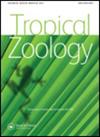Population parameters of two water scavenger beetles: Derallus angustus Sharp, 1882 and Enochrus vulgaris (Steinheil, 1869) (Coleoptera: Hydrophilidae) in permanent ponds: spatial distribution and microhabitat preference
IF 0.7
4区 生物学
Q4 ZOOLOGY
引用次数: 3
Abstract
The spatial distribution, temporal variation, and microhabitat preference of two populations of aquatic Coleoptera were analysed in permanent ponds located in the province of Corrientes, Argentina. Samples were collected every 15 days, between October 2010 and October 2011. The dispersion index and distribution models (Poisson Series, positive binomial and negative binomial) were used to evaluate the spatial distribution. For the evaluation of the microhabitat preference we used non-parametric Kruskal–Wallis test and then the Dunn test with the Bonferroni’s correction. In the test of the use of different microhabitats, we used a K proportion test and, when significant, a two proportion Z test was applied between pairs of microhabitats. The species analysed were the hydrophilids Derallus angustus Sharp and Enochrus vulgaris (Steinheil). The results indicate that the spatial distribution of individuals was mostly related to the homogeneity or heterogeneity of the ecosystem. However, when species were analysed individually, the spatial distribution and the use of microhabitat by each of them were different with respect to preference and behaviour. The macrophytes also play a role in the dynamics of these species, as they favour or limit the abundance by modifying the structure thereof.两种食水甲虫:Derallus angustus Sharp,1882和Enochrus vulgaris(Steinheil,1869)(鞘翅目:水螅科)在永久池塘中的种群参数:空间分布和微生境偏好
在阿根廷科连特斯省的永久性池塘中,分析了两个水生鞘翅目种群的空间分布、时间变化和微生境偏好。2010年10月至2011年10月,每15天采集一次样本。离散指数和分布模型(泊松级数、正二项式和负二项式)用于评估空间分布。为了评估微生境偏好,我们使用了非参数Kruskal–Wallis检验,然后使用了带有Bonferroni校正的Dunn检验。在使用不同微生境的测试中,我们使用了K比例测试,当显著时,在成对的微生境之间应用了两个比例的Z测试。所分析的物种为嗜水气植物Derallus angustus Sharp和Enochrus vulgaris(Steinheil)。结果表明,个体的空间分布主要与生态系统的同质性或异质性有关。然而,当对物种进行单独分析时,每个物种的空间分布和对微栖息地的使用在偏好和行为方面都有所不同。大型植物也在这些物种的动态中发挥作用,因为它们通过改变其结构来促进或限制丰度。
本文章由计算机程序翻译,如有差异,请以英文原文为准。
求助全文
约1分钟内获得全文
求助全文
来源期刊

Tropical Zoology
生物-动物学
CiteScore
2.50
自引率
0.00%
发文量
1
审稿时长
>12 weeks
期刊介绍:
Tropical Zoology is an international zoological journal publishing original papers in the field of systematics, biogeography, phylogeny, ecology and conservation of all terrestrial and aquatic animal Phyla from tropical and subtropical areas.
Only papers with new information, high quality and broad interest are considered. Single species description and checklists are not normally accepted. Review papers are welcome. The journal is owned by the Istituto di Ricerca sugli Ecosistemi Terrestri of the Consiglio Nazionale delle Ricerche, Florence, Italy (CNR-IRET) who performs research into the structure and functioning of aquatic and terrestrial ecosystems, focusing in particular on anthropogenic pressure and global change. The knowledge amassed forms the scientific basis for identifying the most appropriate protective and corrective interventions, and provides support for the bodies entrusted with formulating policies for environmental protection and recovery.
 求助内容:
求助内容: 应助结果提醒方式:
应助结果提醒方式:


